Pacific Profiles Vol 3
Allied Medium Bombers: Douglas A-20 Havoc
Southwest Pacific 1942-1944
by Michael Claringbould
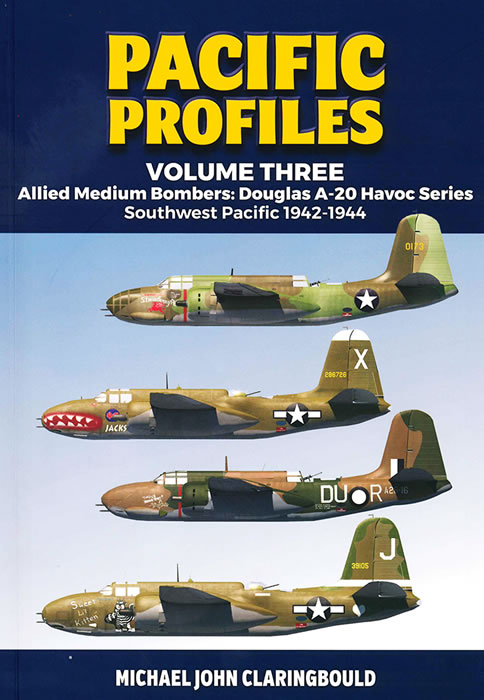
Avonmore Books
S u m m a r y : |
Catalogue Number, Description and ISBN: |
Pacific Profiles Vol. 3
Allied Medium Bombers: Douglas A-20 Havoc
Southwest Pacific 1942-1944
by Michael Claringbould
Avonmore Books |
ISBN: |
978-0-6489262-0-7 |
Contents & Media: |
112 pages, 25cm x 18cm, many colour profiles and photographs of those aircraft. |
Price: |
AUD$34.95 plus shipping available online from Avonmore Books and hobby book retailers worldwide |
Review Type: |
First Look |
Advantages: |
Detailed and comprehensive look at the Allied Medium bombers, specifically the Douglas A-20 Havoc in the Southwest Pacific from 1942 to 1944, with excellent informative text, historical photos and matching aircraft profiles, as well as details of the units that flew them. |
Disadvantages: |
None noted. |
Conclusion: |
A great, should have, reference for modellers of all scales interested in the early years of the Pacific theatre, especially Allied aircraft, in this case the A-20 Havoc during WWII. |
Reviewed by David Couche

This book, the “Pacific Profiles Vol 3, Allied Medium Bombers: Douglas A-20 Havoc, Southwest Pacific 1942-1944” describes this aircraft used by the Allied forces, in aerial bombing as well as ground support, and based in New Guinea and the Celebes Islands from 1942 until 1944.
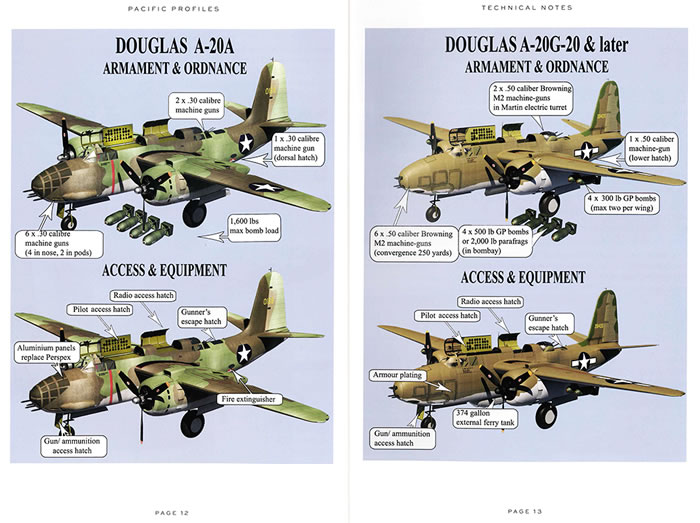
Michael Claringbould, the author, presents this book in chapters on each of the US Bombardment Groups as well as the RAAF units.
Before getting into each of these Bombardment groups, he provides a Technical notes overview, in 6 pages with maps, of the locations where the Havoc were based in the Southwest Pacific as well as technical notes covering each of the A-20 (A and G) types that were operated in this area, clearly showing differences with full page annotated drawings.
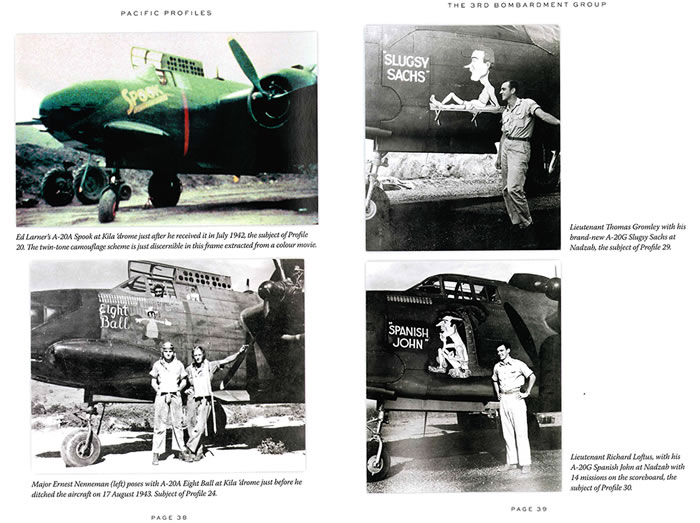
Following on is a chapter covering marking used by these Havocs. The author covers the Bombardment Group markings, all on the tail units of the aircraft and the various squadron markings within each group. He discusses nose art which is quite prominent on most of these aircraft as well as how weathering and packing markings (the really obvious lines on the noses of many Havoc’s due to damage from this tape when packed in the US) greatly affected the look of the Havoc aircraft. Michael does supply a very detailed set of drawings with all markings on a Hamilton Standard propeller used with the R-2600 radial engines.
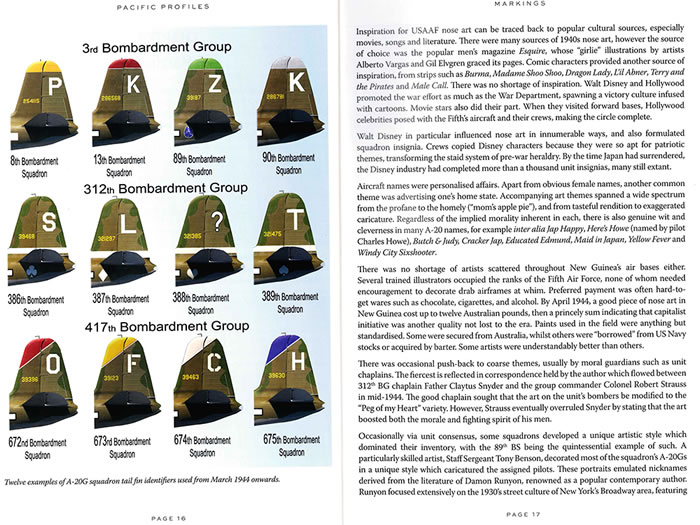
Michael then looks at each of the Bombardment Groups as individual chapters and then further breaks is into subsections of the various squadrons in those groups. The book then consists of only 3 chapters but with 4 squadrons within each of these. The final chapters cover miscellaneous US Havoc used as transports etc within the area of operations, RAAF squadrons and use and then an in depth look at one well known A-20G’s “The Hell’N Pelican II” in its many schemes on it from November 1943 to April 1944.
The chapters of the book are:
-
Technical Notes
-
Markings
-
The 3rd Bombardment Group
3.1 The 8th Bombardment Squadron
3.2 The 13th Bombardment Squadron
3.3 The 89th Bombardment Squadron
3.4 The 90th Bombardment Squadron
- The 312th Bombardment Group
4.1 The 386th Bombardment Squadron
4.2 The 387th Bombardment Squadron
4.3 The 388th Bombardment Squadron
4.4 The 389th Bombardment Squadron
- The 417th Bombardment Group
5.1 The 672nd Bombardment Squadron
5.2 The 673rd Bombardment Squadron
5.3 The 674th Bombardment Squadron
5.4 The 675th Bombardment Squadron
-
Miscellaneous USAAF A-20’s
-
RAAF A-20’s
-
A-20G’s “The Hell’N Pelican II
Each of these Squadron’s has detailed notes on what variant of aircraft flew, at what time period as well as other valuable information. Each chapter follows the same construction with written text on that Squadron, a page (and often more than one page) of numbered aircraft profiles with more detailed notes on the adjoining page. There are original historical photographs of those aircraft which provides an excellent reference for those of us who are modellers. Some chapters have very rare colour photographs of the respective aircraft, with the correlation between original photos and the profiles provided.
The next of the chapter covers the miscellaneous older A-20’s, no longer suitable for combat units, that were used as squadron “hacks” and “fatcats”. The “fatcats” were named because they delivered airmen to Australian cities for leave and returned with fresh food, fruit, alcohol and other supplies.
Chapter 7 is a relatively brief chapter on the RAAF use of the Havoc, or the Boston III as it was known in Australia. Only 2 squadrons flew this aircraft, 18 Squadron initially and then 22 Squadron. Again, some very nice colour profiles support the historical notes and historical phtotographs.
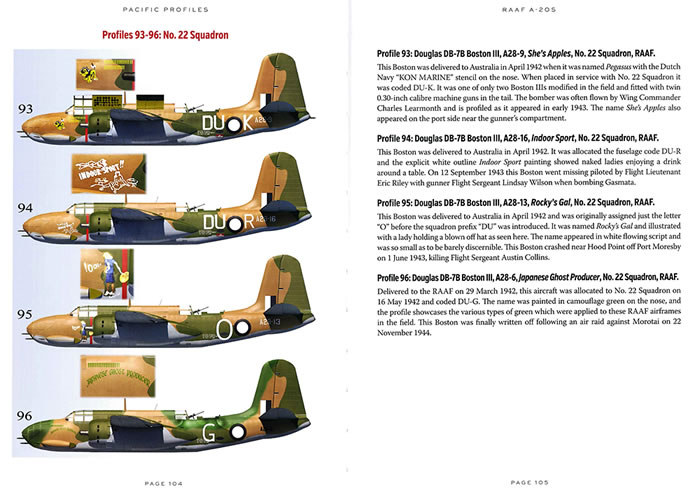
The final chapter is set around a single aircraft, Douglas A-20G-20-DO #42-86786. It only survived 5 months in theatre but had 4 different schemes and flew combat in 3 different USAAF squadrons before crash landing in April 1944. This aircraft was rediscovered by the author in 1976 and the RAAF salvaged it and it has now been restored and is on display in Australia.
This book, the third volume of the Pacific Profiles series, is an excellent reference for modellers with an interest in the Pacific southwestern theatre, especially builders of Allied aircraft.
I would see this as a highly desireable addition to your library and highly recommend it for its thoroughness of this aircraft.
Having a couple of these kits in the stash, I will be definitely using this book for my references in these builds .
Many thanks to Avonmore Books for the review sample.
Review Copyright © 2022 by David Couche
This Page Created on 18 May, 2022
Last updated
18 May, 2022
Back to HyperScale Main Page
Back to Reviews Page

|
